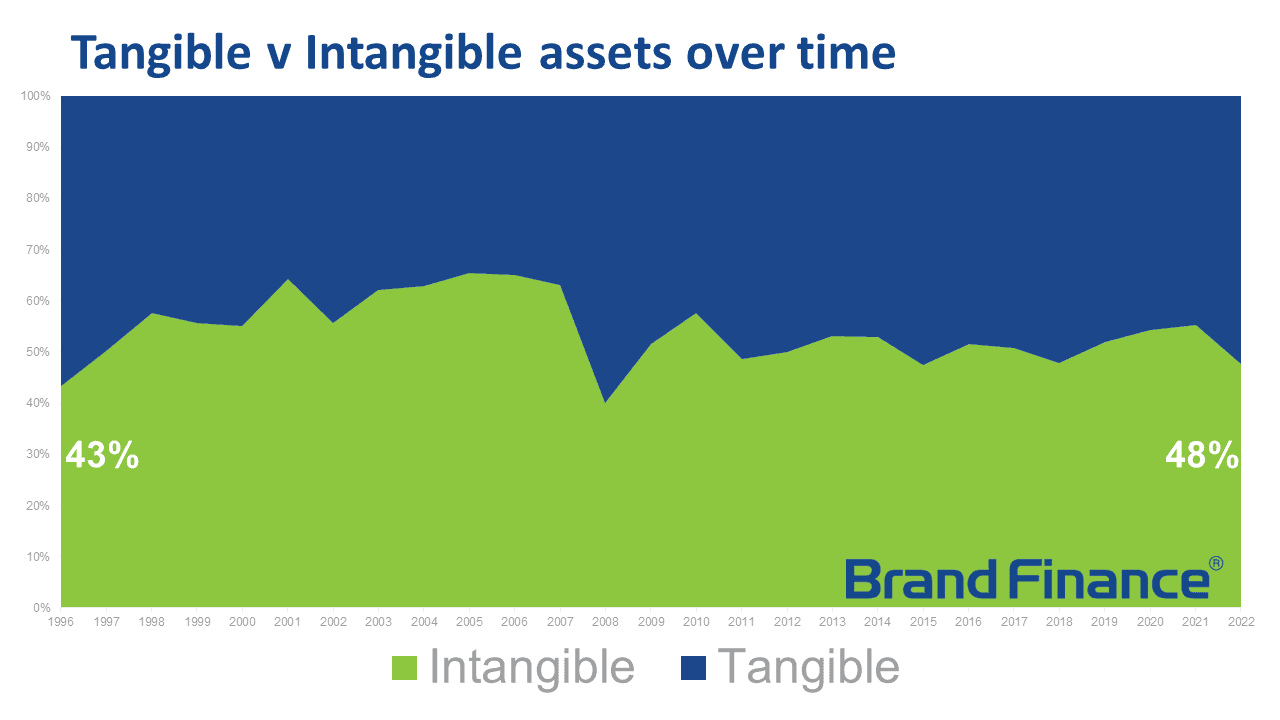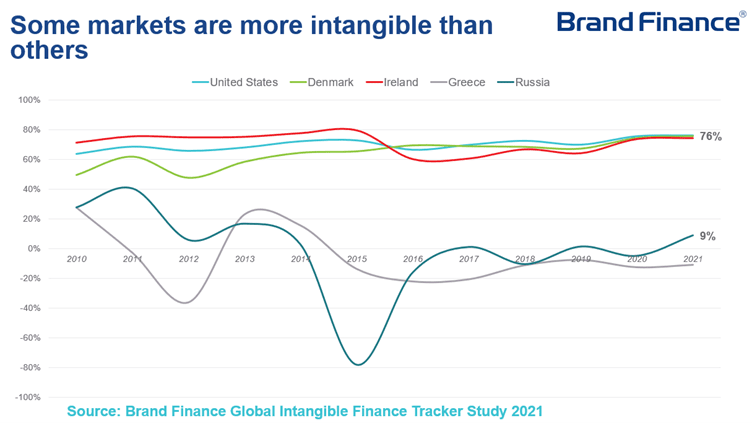O financiamento da marca realiza pesquisas globais sobre o valor total intangível das empresas listadas publicamente através do nosso "Relatório Global Intangible Finance Tracker" (ou presente) Relatório. Construímos nesta pesquisa para analisar o valor dos intangíveis de marketing como parte de nossa outra pesquisa. frase “ativos intangíveis” para se referir a uma ampla variedade de recursos identificáveis sob o controle de uma empresa que trará benefícios econômicos para a empresa, mas que não são monetários e não assumirão a forma física. De acordo com os padrões internacionais de relatórios financeiros, esses ativos são identificáveis quando são separáveis do negócio ou identificados em direitos contratuais e/ou legais. Eles tendem a se encaixar em grande parte dentro de cinco classes - marketing, contratual, clientes, intangíveis artísticos ou tecnológicos - além de boa vontade que surge de “sinergias” - ou benefícios multiplicativos - relacionados ao seu uso combinado. Por serem bens não rival que geralmente são difíceis de colateralizar, geralmente é mais fácil financiar investimentos em ativos intangíveis por meio da equidade. países, ativos intangíveis estão se tornando muito mais importantes e valiosos, isso às vezes é representado para ser representativo da economia mundial. Mas grande parte do mundo não se beneficiou de um crescimento equivalente no valor dos ativos intangíveis. Esse número mudou muito pouco desde que começamos a medir em 1996. Observamos que houve uma proporção um pouco maior de intangíveis reservados desde 2003, quando os intangíveis adquiridos foram obrigados a serem reservados em balanços, mas a progressão foi lenta. Para o mercado público dos EUA como um todo, descobrimos que apenas 73% do valor total do ativo é contabilizado por ativos intangíveis-um número que provavelmente é menor ao considerar a grande maioria dos pequenos e micro empresas de pequenas e micro. Empresas. Os mercados de ações grandes e líquidas são ideais para financiar esses ativos intangíveis. Espanha e Itália, por exemplo, com apenas um pouco mais de 50% de valor intangível cada. Em outros lugares, na Grécia e na Rússia, o número está mais próximo de 0%, pois o valor dos negócios é menor do que os ativos tangíveis líquidos. Mesmo antes da recente invasão russa da Ucrânia, o valor da Bolsa de Valores de Moscou era inferior a 3% da Bolsa de Valores de Nova York, um reflexo do tamanho relativamente pequeno dos mercados de capitais públicos nessa jurisdição.
Brand Finance conducts this research because valuation of intangibles is one of the most intractable problems with IP financing and our studies are meant to be part of the solution of finding reliable, replicable valuations that can be used to understand the source of a company’s financial success and therefore provide information on how to finance it.
We use the phrase “intangible assets” to refer to a wide variety of identifiable resources under the control of a business that will bring economic benefits to the company but that are non-monetary and do not take physical form. According to the international financial reporting standards, these assets are identifiable when they are separable from the business or identified within contractual and/or legal rights. They tend to fit largely within five classes – Marketing, Contractual, Customer, Artistic or Technological intangibles – plus goodwill which arises from “synergies” – or multiplicative benefits – related to their combined use.
One challenge with intangible assets is that they are not very conducive to debt financing. Because they are non-rival goods which are often difficult to collateralise, it is often easier to finance investments in intangible assets through equity.
Many people point to the growing importance and value of intangible assets through an oft-quoted statistic that the value of intangible assets has risen from 17% of the value of the S&P 500 in 1975 to around 90% now in 2022. While it is true that in some highly developed countries, intangibles assets are becoming much more important and valuable, this is sometimes held out to be representative of the world’s economy. But much of the world has not benefited from an equivalent growth in value of intangible assets.
Our latest GIFT study shows that about 48% of the world’s stock market value is derived from intangible assets, a long way behind the US’s 90%. That figure has changed very little since we started measuring in 1996. We do note that there has been a slightly higher proportion of booked intangibles since 2003 when purchased intangibles were required to be booked on balance sheets but the progression has been slow.

For even publicly listed US stocks in total (including those outside the S&P 500), much less than 90% of the listed value comes from intangible assets. For the US public market as a whole, we find that only 73% of total asset value is accounted for by intangible assets – a number that is likely lower when considering the vast majority of privately held small and micro businesses.
While the US features a number of large, high-value, multi-national corporations which have successfully grown and financed their intellectual property, it is not always so easy in other countries and with smaller companies.
Deep equity markets, with a sophisticated and knowledgeable network of investors, high levels of understanding of intangible asset development, the best universities in the world and a market that makes it relatively easy to roll-out technology across a large market size means that many big companies are able to finance investment in intangibles relatively easily. Big and liquid equity markets are ideal for funding such intangible assets.
For smaller US companies and for those in other countries without those advantages – or at least with those resources in less abundance – we find much lower intangible asset values. Spain and Italy for example having only a little over 50% intangible value each. Elsewhere, in Greece and Russia, the figure is closer to 0% as the value of business is less than even the net tangible assets. Even before the recent Russian invasion of Ukraine, the value of the Moscow Stock Exchange was less than 3% of the New York Stock Exchange, a reflection of the relatively tiny size of public capital markets in that jurisdiction.

Dito isto, em muitos países, como os EUA, Dinamarca e Irlanda, como você pode ver no gráfico, bem como em muitos outros países desenvolvidos, a proporção de valor intangível nas empresas está aumentando significativamente e precisa ser sustentado. Os países da esfera anglo-fé e das nações da União Europeia se beneficiam de mercados de capitais substancialmente mais desenvolvidos. Investimento de diferentes opções de arquitetura da marca e posicionamento da marca. Grande parte dessa experiência se concentrou em identificar as estruturas da marca, o investimento em mídia, o mix de mídia e o gerenciamento de canais de distribuição necessários para minimizar o risco e maximizar a oportunidade de qualquer alteração da marca. Diploma antecipado em impostos internacionais, com especialização em preços de transferência. Ele possui um diploma duplo em Economia e Política Ambiental pela London School of Economics e concluiu o treinamento em análise de dados e estratégia de marketing. Ele trabalhou internacionalmente em todos os continentes e na maioria dos setores e agora gerencia as equipes da marca e o trabalho do cliente em toda a Ásia e Australásia.